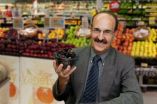(Press-News.org) Every day we make thousands of tiny predictions — when the bus will arrive, who is knocking on the door, whether the dropped glass will break. Now, in one of the first studies of its kind, researchers at Washington University in St. Louis are beginning to unravel the process by which the brain makes these everyday prognostications.
While this might sound like a boon to day traders, coaches and gypsy fortune tellers, people with early stages of neurological diseases such as schizophrenia, Alzheimer's and Parkinson's diseases could someday benefit from this research. In these maladies, sufferers have difficulty segmenting events in their environment from the normal stream of consciousness that constantly surrounds them.
The researchers focused on the mid-brain dopamine system (MDS), an evolutionarily ancient system that provides signals to the rest of the brain when unexpected events occur. Using functional MRI (fMRI), they found that this system encodes prediction error when viewers are forced to choose what will happen next in a video of an everyday event.
Predicting the near future is vital in guiding behavior and is a key component of theories of perception, language processing and learning, says Jeffrey M. Zacks, PhD, WUSTL associate professor of psychology in Arts & Sciences and lead author of a paper on the study in a forthcoming issue of the Journal of Cognitive Neuroscience.
"It's valuable to be able to run away when the lion lunges at you, but it's super-valuable to be able to hop out of the way before the lion jumps," Zacks says. "It's a big adaptive advantage to look just a little bit over the horizon."
Zacks and his colleagues are building a theory of how predictive perception works. At the core of the theory is the belief that a good part of predicting the future is the maintenance of a mental model of what is happening now. Now and then, this model needs updating, especially when the environment changes unpredictably.
"When we watch everyday activity unfold around us, we make predictions about what will happen a few seconds out," Zacks says. "Most of the time, our predictions are right.
"Successfull predictions are associated with the subjective experience of a smooth stream of consciousness. But a few times a minute, our predictions come out wrong and then we perceive a break in the stream of consciousness, accompanied by an uptick in activity of primitive parts of the brain involved with the MDS that regulate attention and adaptation to unpredicted changes."
Zacks tested healthy young volunteers who were shown movies of everyday events such as washing a car, building a LEGO model or washing clothes. The movie would be watched for a while, and then it was stopped.
Participants then were asked to predict what would happen five seconds later when the movie was re-started by selecting a picture that showed what would happen, and avoiding similar pictures that did not correspond to what would happen.
Half of the time, the movie was stopped just before an event boundary, when a new event was just about to start. The other half of the time, the movie was stopped in the middle of an event. The researchers found that participants were more than 90 percent correct in predicting activity within the event, but less than 80 percent correct in predicting across the event boundary. They were also less confident in their predictions.
"This is the point where they are trying hardest to predict the future," Zacks says. "It's harder across the event boundary, and they know that they are having trouble. When the film is stopped, the participants are heading into the time when prediction error is starting to surge. That is, they are noting that a possible error is starting to happen. And that shakes their confidence. They're thinking, 'Do I really know what's going to happen next?' "
Zacks and his group were keenly interested in what the participants' brains were doing as they tried to predict into a new event.
In the functional MRI experiment, Zacks and his colleagues saw significant activity in several midbrain regions, among them the substantia nigra — "ground zero for the dopamine signaling system" — and in a set of nuclei called the striatum.
The substantia nigra, Zacks says, is the part of the brain hit hardest by Parkinson's disease, and is important for controlling movement and making adaptive decisions.
Brain activity in this experiment was revealed by fMRI at two critical points: when subjects tried to make their choice, and immediately after feedback on the correctness or incorrectness of their answers.
Mid-brain responses "really light up at hard times, like crossing the event boundary and when the subjects were told that they had made the wrong choice," Zacks says.
Zacks says the experiments provide a "crisp test" of his laboratory's prediction theory. They also offer hope of targeting these prediction-based updating mechanisms to better diagnose early stage neurological diseases and provide tools to help patients.
INFORMATION:
Editor's Note: Zacks can be reached for interview by phone at 314-935-8454; or email: jzacks@wustl.edu.
Everyday clairvoyance: How your brain makes near-future predictions
2011-08-19
ELSE PRESS RELEASES FROM THIS DATE:
Towing Guru Cites Google Maps as Another Tool That Can Improve Search Engine Optimization (SEO) When Online Marketing for Towing Companies
2011-08-19
Towing Guru provides a full range of services in online marketing for towing companies. There are countless opportunities for towing marketing on the Internet. Google's My Maps is an exceptional free tool that can improve a towing company's search engine optimization (SEO), which gets local businesses found by consumers.
What a towing company can do in My Maps is provide a valuable service for consumers. At the same time, My Maps is a powerful towing marketing strategy.
Google My Maps is a customizable tool used to create user-generated maps. A towing company might ...
Ambitious goals = satisfaction
2011-08-19
RIVERSIDE, Calif. (www.ucr.edu) -- Consumers who set ambitious goals have a greater level of satisfaction compared to those who set conservative goals, according to a recently published paper by the Cecile K. Cho, a University of California, Riverside assistant marketing professor.
Cho and her co-author and Gita Venkataramani Johar, a professor at Columbia University, set up two experiments to compare people who set ambitious goals to those who set conservative goals. They focused on situations in which goals were achieved, and measured the level of satisfaction with ...
Common vein condition increases risk for developing life-threating blood clots
2011-08-19
(WASHINGTON, August 17, 2011) –Patients with clinically diagnosed superficial vein thrombosis (SVT), a blood clot in the veins just beneath the skin that commonly resolves on its own without treatment, are four to six times more likely to develop venous thromboembolism (VTE), a dangerous, often life-threatening condition, according to study results published today in Blood, the Journal of the American Society of Hematology (ASH).
Recent studies have shown that patients diagnosed with SVT using ultrasound to confirm the presence of a clot showed increased risk of VTE; ...
New method can speed development of organic semiconductors for flexible displays
2011-08-19
Organic semiconductors hold immense promise for use in thin film and flexible displays – picture an iPad you can roll up – but they haven't yet reached the speeds needed to drive high definition displays. Inorganic materials such as silicon are fast and durable, but don't bend, so the search for a fast, durable organic semiconductor continues.
Now a team led by researchers at Stanford and Harvard universities has developed a new organic semiconductor material that is among the speediest yet. The scientists also accelerated the development process by using a predictive ...
GOES-11 satellite sees Tropical Storms Fernanda and 'little brother' Greg chasing each other
2011-08-19
The Eastern Pacific Ocean is fired up with two tropical storms today, Fernanda and Greg, and both were caught in one image from the GOES-11 satellite. Both appear to be chasing each other to the west, and Fernanda appears a little more organized in satellite imagery and stronger than her "little brother."
The newest tropical storm, Greg, formed this morning, August 17 off the west coast of Mexico from a low previously known as System 99E. Greg is about 135 miles (220 km) south-southwest of Zihuatanejo, Mexico. Because Greg is close to the western coast of Mexico, the ...
Model shows polar ice caps can recover from warmer climate-induced melting
2011-08-19
A growing body of recent research indicates that, in Earth's warming climate, there is no "tipping point," or threshold warm temperature, beyond which polar sea ice cannot recover if temperatures come back down. New University of Washington research indicates that even if Earth warmed enough to melt all polar sea ice, the ice could recover if the planet cooled again.
In recent years scientists have closely monitored the shrinking area of the Arctic covered by sea ice in warmer summer months, a development that has created new shipping lanes but also raised concerns about ...
Moon and Earth may be younger than originally thought
2011-08-19
LIVERMORE, Calif. -- New research using a technique that measures the isotopes of lead and neodymium in lunar crustal rocks shows that the moon and Earth may be millions of years younger than originally thought.
The common estimate of the moon's age is as old as 4.5 billion years old (roughly the same age as the solar system) as determined by mineralogy and chemical analysis of moon rocks gathered during the Apollo missions. However, Lawrence Livermore National Laboratory scientist Lars Borg and international collaborators have analyzed three isotopic systems, including ...
No bones about it: Eating dried plums helps prevent fractures and osteoporosis
2011-08-19
When it comes to improving bone health in postmenopausal women — and people of all ages, actually — a Florida State University researcher has found a simple, proactive solution to help prevent fractures and osteoporosis: eating dried plums.
"Over my career, I have tested numerous fruits, including figs, dates, strawberries and raisins, and none of them come anywhere close to having the effect on bone density that dried plums, or prunes, have," said Bahram H. Arjmandi, Florida State's Margaret A. Sitton Professor and chairman of the Department of Nutrition, Food and Exercise ...
Study finds majority of pharmaceutical ads do not adhere to FDA guidelines
2011-08-19
A study led by Mount Sinai School of Medicine researchers of 192 pharmaceutical advertisements in biomedical journals found that only 18 percent were compliant with Food and Drug Administration (FDA) guidelines, and over half failed to quantify serious risks including death. The study, is published online today in the journal Public Library of Science (PLoS) One.
"Marketing research has consistently shown that journal advertising is the most profitable form of drug marketing, with an estimated return on investment of five dollars for every dollar spent," said Dr. Deborah ...
23andMe replicates over 180 genetic associations with Web-based research platform
2011-08-19
MOUNTAIN VIEW, CA – (August 17, 2011) – 23andMe, Inc., a leading personal genetics company has replicated over 180 genetic associations from a list of associations curated by the National Human Genome Research Institute's Office of Population Genomics ("GWAS Catalog") demonstrating that self-reported medical data is effective and reliable to validate known genetic associations. The results, available online in the journal PLoS ONE establish 23andMe's methodology as a significant research platform in a new era of genetic research.
"In this paper we confirm that self reported ...



